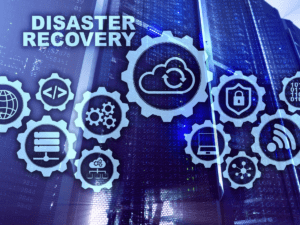In today’s digital era, securing data and ensuring business continuity are essential. However, many companies might not be fully aware of the real threats they face and the solutions available to mitigate them. Let’s delve into the insights provided by Complete Business Systems (CBS) to grasp the importance of IT disaster recovery.
The Looming Threats:
1. Natural Disasters: Unpredictable in nature, these can strike anytime, anywhere. The aftermath of a natural calamity can devastate infrastructure, resulting in loss of critical data. The strategy to combat this? Full, reliable backups. CBS emphasizes the significance of geographical redundancies – ensuring that even if the primary data location is compromised, a backup is at the ready in another location.
2. Cyber Crime: The digital world’s pitfalls. Hackers and ransomware attacks are increasingly sophisticated, employing a myriad of tactics such as phishing emails, malicious text messages, and deceptive phone calls. A single error from an employee can result in substantial harm, leaving your business’s network vulnerable.
Why IT Disaster Recovery is Essential:
- Business Continuity: Any disruption, be it a minor glitch or a major cyber-attack, can interrupt operations. A disaster recovery plan ensures that businesses can continue functioning even during crises.
- Protecting Business Reputation: Downtimes, data breaches, or loss of client data can severely damage a company’s reputation. An effective disaster recovery plan safeguards not just the data but also the trust that stakeholders place in the business.
- Financial Impact: Downtimes can result in significant financial losses. Moreover, post-disruption recovery can be expensive if there’s no pre-established plan.
- Regulatory and Compliance Requirements: Many industries are mandated by law to have certain data protection measures in place. An IT disaster recovery plan can help meet these compliance requirements.
Building an Effective IT Disaster Recovery Plan:
- Identify Critical Assets: Determine which systems, applications, and data are vital for the business. Knowing what’s critical helps in prioritizing recovery strategies.
- Designate a Disaster Recovery Team: Assign a dedicated team responsible for executing the disaster recovery plan. Ensure they undergo regular training and are updated on best practices.
- Data Backup Strategy: Implement regular data backups. Consider using a combination of on-site and cloud-based backups for redundancy. Ensure these backups are tested regularly for integrity.
- Communication Plan: In case of a disaster, transparent communication is key. Have a clear communication plan outlining who informs stakeholders and how.
- Test and Update: A disaster recovery plan is not a one-time task. It needs regular testing to identify loopholes and areas of improvement. Moreover, as the business evolves, the plan must be updated to reflect changes in assets and priorities.
Leveraging Professional Expertise:
While understanding the importance of IT disaster recovery is the first step, implementing it effectively might require expertise. Partnering with IT professionals who specialize in disaster recovery can ensure that the business is not just prepared but resilient in the face of unforeseen challenges.
The CBS Approach:
CBS’s solution to these threats follows a systematic and thoughtful process:
1. Assessment: Start by understanding the existing infrastructure, identifying technology and users at risk, and outlining potential threats.
2. Expectations: Drafting a detailed plan ensures clarity and sets the right expectations, ensuring businesses know what they’re signing up for.
3. Implementation: Leveraging years of experience, CBS transforms the strategy into action, ensuring data is thoroughly backed up and businesses can recover swiftly after an adversity.
4. Optimization: The IT landscape is ever-evolving. CBS’s approach isn’t static. They continuously collaborate with businesses, refining strategies to counter new vulnerabilities stemming from technology and software changes.
IT disaster recovery isn’t an option; it’s a necessity. Businesses today must acknowledge the threats lurking around and adopt robust measures to protect their data. With experts like CBS at the helm, navigating these challenges becomes a tad easier. Remember, in the digital realm, it’s always better to be safe than sorry!